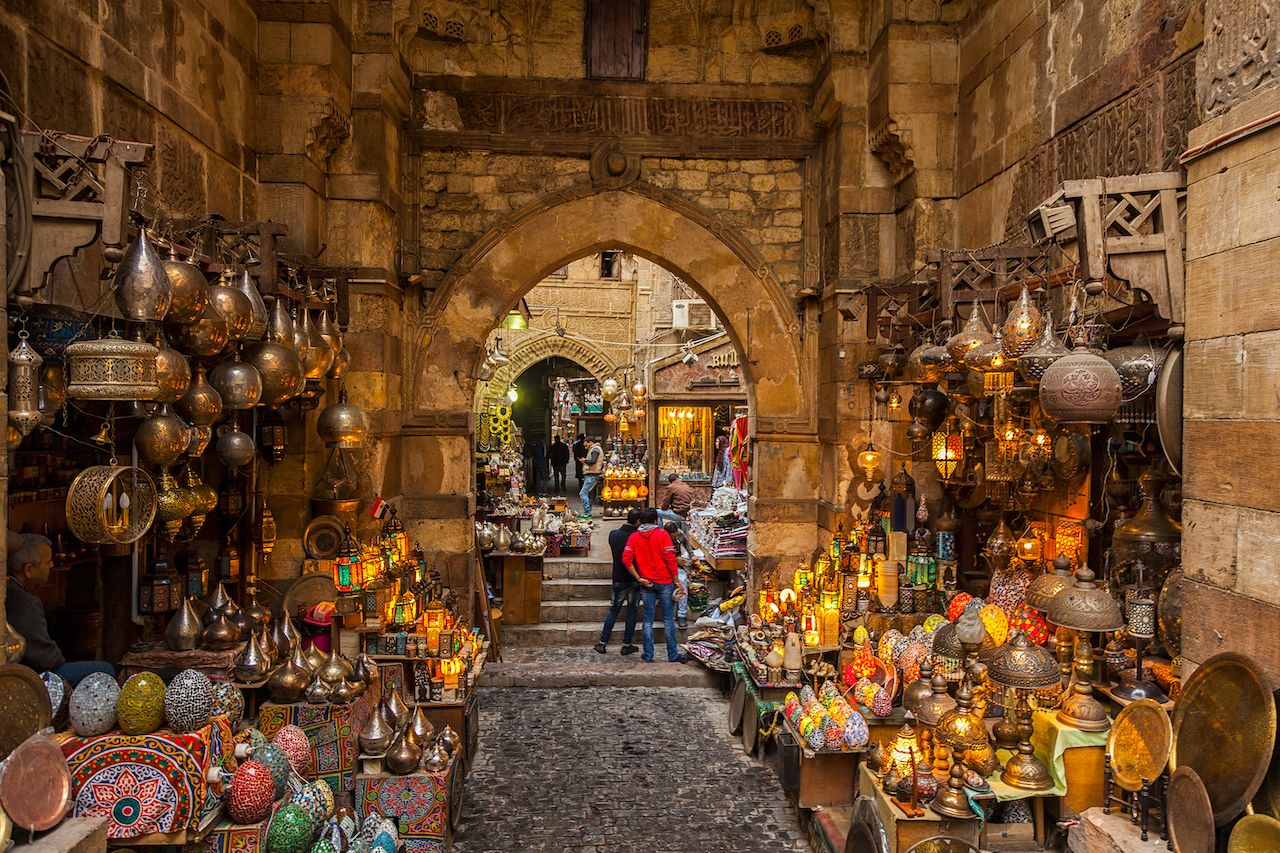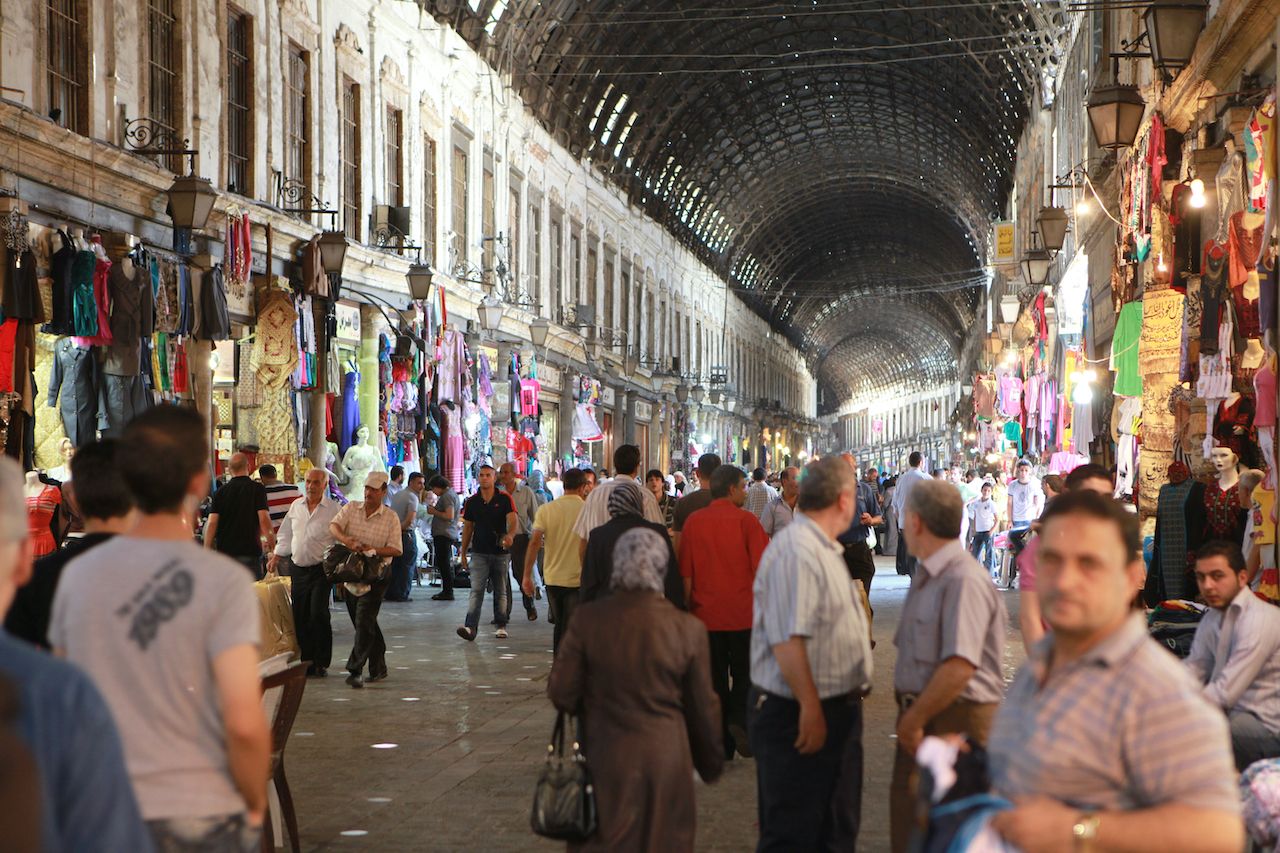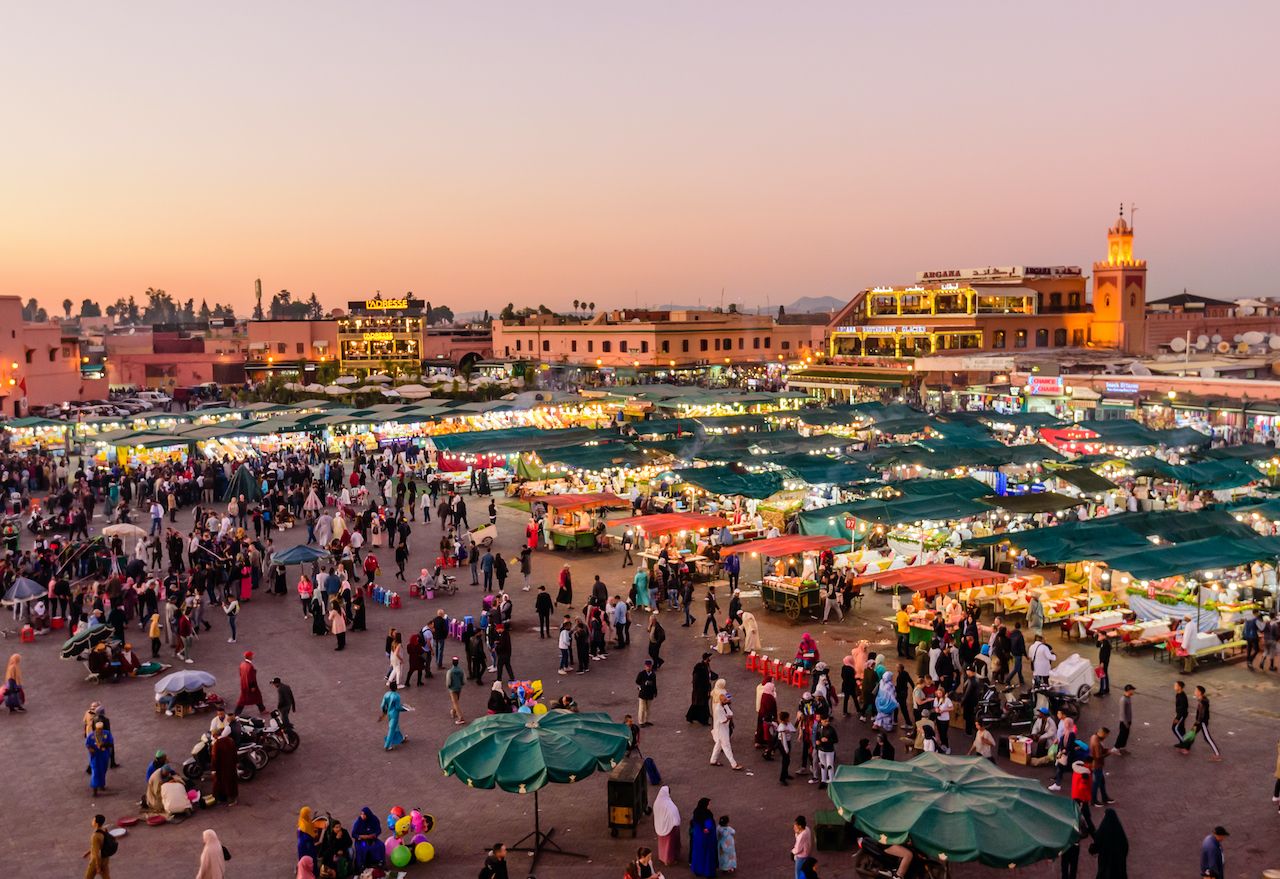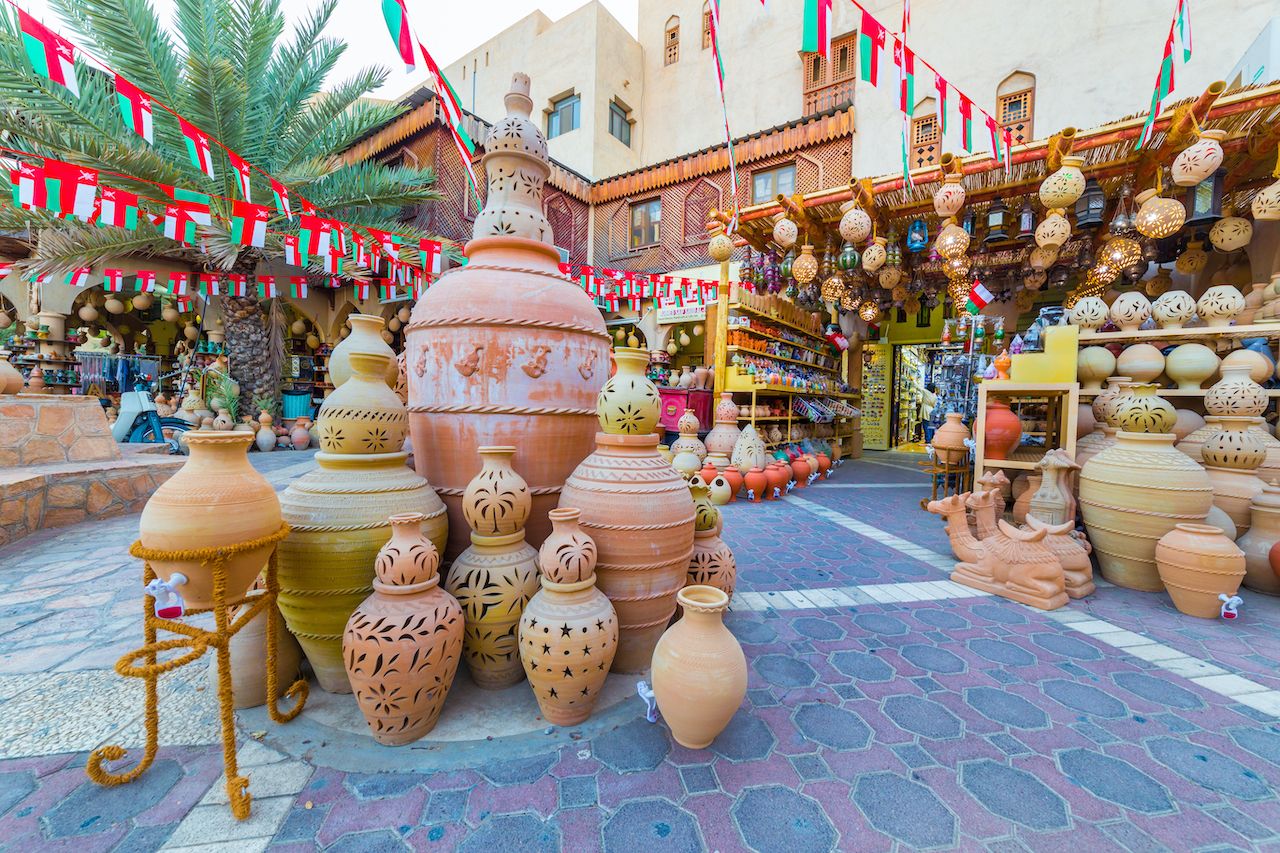If it were possible to distill the essence of the Middle East and North Africa into a single experience, it would be a jaunt through the spice-ladened air of a busy souq. Souqs, collections of adjacent vendors often sprawled out over a plaza or multiple semi-enclosed streets, have served as the economic hubs of Middle Eastern metropolises since their first appearance, which some researchers contend was as early as 2,000 BC.


The 7 Most Extraordinary Souqs From Around the World
Despite the vast distances and imposing geographies separating them, the major cities in North Africa, the Levant, and the Gulf have historically been connected by an extensive web of trade routes, such as the King’s Highway and the Silk Road. Merchants used this infrastructure to transport incense, spices, fruits, nuts, gold, glassware, jewelry, cloth, dyes, timber, perfumes, and more from city to city.
These same traders required spaces where they could display and sell their products, and it was out of this need that the souq flourished. Some souqs were dedicated to one type of ware while others contained dozens of shops, each selling a specific category of product. Intangible but equally important, culture and knowledge were freely exchanged at souqs, forging a sense of interconnectedness among disparate peoples.
While the days when traders traveling with caravans would stop to unload and sell their products are gone, these ancient marketplaces have not been abandoned. Both locals and tourists continue to frequent souqs all across the world. Visiting all of them would be a challenge, so here are the ones whose history, architecture, surroundings, and products are the most extraordinary.
1. Old City, Jerusalem

Photo: eFesenko/Shutterstock
While better known as home to some of the world’s holiest and most contested religious sites, Jerusalem’s Old City is also one of the world’s most interesting souqs.
Rising on both sides of a labyrinth of narrow stone streets are buildings whose ground floors are occupied by shops, restaurants, bakeries, and butchers. Upper levels often serve as residences for the owners of the businesses below, as hostel rooms, or as quarters for a religious order. Over some stretches of the Old City, arched roofing shades shoppers while in others, balconies provide the only respite from the sun. There are four quarters in the Old City: Christian, Muslim, Armenian, and Jewish. Each has something to offer, so set aside time to explore all four.
People-watching is almost as entertaining as the contents of the souq itself. While navigating the narrow streets and dodging the occasional cart piled high with baked goods or dates, tourists hunt for pashmina scarves or bejeweled camel figurines to bring back home. Others stop to admire strands of colorful beads hung outside a shop’s entrance, or to inspect the beautiful ceramics for which the Armenians are famous. Hungry from hours of exploring, still others purchase and munch on zalabia, a delectable, curlicue-shaped fried dough saturated in honey and rose water.
Once you’ve explored the souq by foot, walk to the Austrian Hospice, which is past Damascus Gate on Via Dolorosa. Stop by the cafe for a refreshing iced coffee with whipped cream, and then head to the roof. For a small fee, you’ll gain access to the best vantage point in the city. The elevation affords a view of the striking gold and blues of the Dome of the Rock; the peaks of old churches; the worn roofs of apartment buildings; and the people scurrying in and out of shops and restaurants.
Of course, the Western Wall, the Church of the Holy Sepulchre, and the mosques on Temple Mount should not be missed. Since they’re located within the Old City, the souq leads up to their doorsteps. Lesser-known spots are hidden within the Holy City for those who don’t mind straying a little, and if you’re already exploring the souq, it would be a shame to skip them.
For example, few people know that it’s possible to do a little spelunking beneath the souq. Zedekiah’s Cave (also known as Solomon’s Quarries) lies just underneath the Muslim Quarter. Access to the cave is located just left of Damascus Gate, and entry is free. Even more fascinating, however, is a mysterious cistern that can only be reached through St. Helena’s Coptic Chapel, which itself is on the roof of the Church of the Holy Sepulchre. Pay a small entrance fee to the resident monk and ask to see Helena’s Well. He’ll direct you to a series of 51 steps leading down to a cavernous chamber containing a few feet of water.
2. Khan el-Khalili, Cairo

Photo: Merydolla/Shutterstock
Cairo, Egypt’s crowded capital, has long been a trade hub. Cairo’s position on the route of the pilgrimage to Mecca for thousands of African Muslims meant that there was a steady flow of people who wanted to stock up on food, clothing, and the like, and the souqs were there to fill their needs. Of those that have survived, the most memorable is Khan el-Khalili.
Although Khan el-Khalili’s existence can’t be traced back to the days of pharaonic Egypt, the presence of a market in the spot certainly isn’t new. The seeds of what would grow into the magnificent marketplace were planted in the 14th century, when Cairo was at the crossroads of trade routes stretching from the Indian Ocean to the Mediterranean. At that point in time, Khan el-Khalili looked more like a khan (an inn inside a caravanserai, which was a group of guest houses where traveling merchants would stay) than it did a souq. In 1511, Sultan Qansuh al-Ghuri destroyed the khan and replaced it with a more souq-like layout, replete with small hotels, warehouses, and shops. Dazzling, tall entrances to the souq were constructed around this time. Just one still stands today, and it’s definitely worth seeing as it is a prime example of Mamluk architecture. Its multicolored stone lobes are surrounded by honeycomb structures, intricate carvings of plants, elegant Arabic calligraphy, and complex geometric patterns.
By dint of its location, Cairo’s Khan el-Khalili overflowed with goods from Asia, Europe, and Africa. Today, the souq caters more toward tourists, but locals do still purchase jewelry there, as Khan el-Khalili contains the country’s largest gold and silver market. For tourists who aren’t looking for such luxuries, there’s a wide variety of cheaper jewelry on sale, as well as an assortment of figurines, papyrus art, coin belts for dancers, clothing, woven rugs, Ramadan lanterns, metal platters, instruments for making and serving coffee, hookahs, and leather slippers.
Bargaining is an essential part of the Khan el-Khalili experience. Some of the goods are cheap, some are artisan. Either way, you should expect that any initial price is a significant markup. Counter an offer with no more than 25 percent of the original price, and go from there. In most cases (except for very fine gold or silver), you shouldn’t pay any more than 40 percent of the starting price.
As exhilarating as haggling is, if you feel drained afterward and need a caffeine fix, you’re in luck. Squeezed inside one of Khan el-Khalili’s narrow alleys is the most famous cafe in Cairo: El Fishawy. Frequented by the likes of famed author and Nobel laureate Naguib Mahfouz, El Fishawy has always been at the heart of Egypt’s intellectual and artistic movements. Warm weather calls for one of the freshly squeezed juices (but hold off on the ice if you don’t want to get sick). If it’s nighttime and a bit nippy out, try a classic like hot mint tea, or be bold and ask for sahlab, a delicious dessert drink with a consistency slightly less viscous than pudding.
3. Souq As-Salt, Jordan

Photo: Rebecca Byrne
While Souq As-Salt is smaller than the fruit and vegetable market in the capital of Amman, it is, in many ways, more worthy of a visit. In fact, it is arguably Jordan’s last traditional souq. Located in a valley between the hills that make up the ancient town of As-Salt, this souq is primarily meant for locals, who come on a daily basis to purchase their produce. Walk along the main road and alleys that make up the souq and you’ll also encounter shoe cobblers and tailors, busy mending residents’ clothing and footwear.
The traditional dress of As-Salt, which includes non-native indigo-dyed fabric, attests to its importance as a locus of trade. Among other items, As-Salt was famous for raisins, which were traded with Jewish merchants in Tiberias for the purpose of making araq, the local anise-flavored liquor. Distributors from Nablus and Jerusalem used As-Salt as a launchpoint for trade to the east of the Jordan River. So significant was the town, in fact, that the Ottomans made it a regional capital.
One of the reasons that As-Salt’s souq is so special is that it resembles those in Syria, which are renowned for their beauty. Hammam Street, which runs through the heart of the souq, is lined with tall, arching wooden doors embedded into 150-year-old stone buildings. Come morning, as people begin to trickle past the tall clock tower in Al Ain Plaza at the souq’s entrance, shop proprietors swing open these massive doors, revealing an array of goods to tempt both people on a grocery run and the casual peruser.
If you plan to hike up the steep hill toward Al-Qala’a — a pink and white stone mosque from where there’s an unbeatable view of the city’s Ottoman architecture — you should first stock up on snacks from the souq. On display is every type of local fruit and vegetable you could imagine, and you can’t go wrong with apples or figs grown on a nearby farm. However, if you want to indulge in a truly authentic Jordanian culinary experience, you should partake in the locals’ fondness for eating raw green almonds soaked in salt water for a totally different take on the poplar nut. If that’s not appetizing enough, opt instead for salt-soaked green cherries, which are like miniature, super crunchy green apples.
Another feature of the souq that recommends itself to tourists is its proximity to two of the city’s biggest highlights: the Harmony Trail and the Abu Jaber House, also known as the Historic Old Salt Museum. The former is a trail that begins at the bottom of As-Salt (at the souq) and cuts a meandering path up the hill that ends at the mosque on the peak (Al-Qala’a). Along the way, the trail hits numerous heritage houses and religious sites, such as the centuries-old Al-Khader Church.
Just across from the entrance to the souq, the Historic Old Salt Museum provides tourists with an archaeological overview of the city’s history. The building itself is a remarkably intact example of Ottoman-era Nablusi architecture.
Once you’ve finished trekking up the hill and perusing the museum, stop back by the souq and pick up an edible souvenir. There are many spices and herbal teas on sale; tea lovers should try the chamomile, which is harvested nearby and hand-dried by the women selling it.
4. Al-Hamidiyah Souq, Damascus

Photo: fpolat69/Shutterstock
Syrian souqs are the most iconic in the world, and for good reasons. From delectable pistachio-covered desserts to expertly crafted walnut wood furniture inlaid with mother of pearl, everything on sale is amazing.
Sadly, the souqs of Aleppo were severely damaged in the civil war. While Damascene souqs did not escape unscathed, they’ve remained much more intact. Souq Al-Hamidiyah in Damascus has been restored to its pre-war beauty and is once again filled with locals and tourists.
All who approach are greeted by the remains of the Roman ruins of the Temple of Jupiter, its 40-foot-tall, slender pillars and graceful arches towering over the pedestrians entering the souq below.
Excavations hint at human activity in the environs as early as 10,000 BCE, but the Damascus that quickly became a commercial hub was founded in the third millennium BCE. Though the spot on which Souq Al-Hamidiyah stands has likely functioned as a marketplace since Roman times, the current structure is much younger, its construction having begun in 1780 during Sultan Hamid’s reign. Remaining work was finished in the 19th century.
One either side of the long path, Souq Al-Hamidiyah is packed with stall after stall of vendors hawking food, clothing, perfumes, jewelry, artisan soap, silk, metalwork, and more. Thanks to a 33-foot-tall metal arch that is interspersed with small round openings, just the right amount of light filters into the souq so that shoppers can see everything without overheating from the sun’s direct rays. Those with extra time can peel off and explore the adjacent souqs that branch off from Al-Hamidiyah and cater to more niche markets.
No visit to Al-Hamidiyah would be complete without trying ice cream from Bakdash. Bakdash is the most celebrated maker of Arabic booza, a type of ice cream that contains sahlab (ground orchid powder) and mastik (a plant resin) and is pounded and stretched in a cold freezer drum in order to achieve a stretchy consistency. The result is a thicker, denser, and extremely creamy ice cream. Employees use their wooden tools to pound and stretch the ice cream in front of hungry onlookers, topping the final creation off with a generous sprinkling of pistachios.
The end of the souq is just as impressive as its entrance. Al-Hamidiyah’s vaulted ceiling gives way to the wide open space of the Umayyad Mosque’s courtyard, believed by Syrians to be the resting place of John the Baptist’s severed head. Originally a Byzantine church, the structure is a gorgeous example of Islamic architecture, making expert use of space, natural light, and geometric motifs.
5. Houmt Souq, Djerba

Photo: BTWImages/Shutterstock
Arabic for “market neighborhood,” Houmt Souq lives up to its name; the entire city, which serves as the default capital of the Tunisian island of Djerba, is like an open-air market. Djerba’s medina (old city center) houses a semi-covered souq, but dispersed in the alleyways that radiate out from this focal point are plenty of additional shops. The entire arrangement creates the impression that much of the town is an extension of the souq.
The walk toward the souq in the medina is an experience in and of itself. Framing the streets are 15th-century buildings with whitewashed exteriors and turquoise-painted balconies that are covered in bougainvillea flowers. As you approach the commercial center, you’ll be met by Djerbians selling leather goods, woven palm baskets, caftans, rugs, pottery, fine jewelry, spices, and fish.
The fish market is perhaps the most famous section of Houmt Souq. Suntanned men auction off as-fresh-as-it-gets seafood. Purchase a fish (or an octopus, if that’s what you’re into) and bring it to a nearby restaurant — they’ll cook it for you on the spot. Once you’ve finished, stroll around the perimeter of the souq and pop into one of the local cafes for a drink.
Houmt Souq’s varied offerings reflect the diversity of Djerba’s inhabitants. The island is home to Tunisia’s largest Jewish population, who have lived on the island for at least 2,500 years. On the peripheries of the souq, the buildings are dotted with Jewish shops, whose proprietors use ancient techniques to fashion magnificent necklaces, bracelets, earrings, rings, and other jewelry. The Ibadis, a Muslim sect that follow a movement that predates the Shia-Sunni split, have also found refuge in Djerba. Both minority groups live in harmony with the majority Sunni population. A visit to Houmt Souq is so much more than a fun shopping trip — it’s a chance to see an oasis of coexistence and multiculturalism.
6. Jemaa el-Fna, Marrakech

Photo: RAndrei/Shutterstock
Jemaa el-Fna is a cacophony of sights, sounds, and smells that is served up on a daily and nightly basis in Marrakech. Owing to its position on the western edge of the early Islamic world, Marrakech has always been a vital stop on trade routes and served as a gate to West Africa. Jemaa el-Fna has been in operation for at least a thousand years and was added to UNESCO’s list of Intangible Cultural Heritage of Humanity in recognition of its immense historical and cultural significance.
In Marrakech’s medina, on a large open plaza, performers weave in and out of the crowds and carts. Snake charmers deftly handle smooth serpents for tips from tourists; acrobats contort and flip through the air; and dancers whirl, their colorful clothing rising and cascading with their jumps.
Curls of intoxicating aromas emanate from the many food carts in the center of the square. All of the options are delicious, but to eat like a Moroccan, order a merguez sausage or a tagine dish. You’ll be spoiled for choice when it comes to tagine, and you can’t go wrong. Either chicken, lamb, or fish is simmered in a medley of spices, often with nuts, a sweet fruit, or tomatoes. If you want to recreate the dish at home, buy a tagine from one of the pottery shops along the edge of the plaza.
Sounds are as pervasive as smells in Jemaa el-Fna. Visitors are constantly inundated by merchants vying for their attention, shouting out the latest deals. Storytellers and poets recount heroic tales and romantic lines, their words set against a background of nearby musicians beating drums and strumming an oud or a hajouj. Few people can say they’ve shopped for hand-woven rugs or locally sourced argan oil beauty products while enjoying what amounts to a free concert, but that’s exactly what you get at Jemaa el-Fna.
In addition to the standard souq wares, Jemaa el-Fna has unusual offerings. Interspersed around the square are booths where the brave can receive folk medicine and amateur dental care. Though it’s wise to avoid partaking in these particular experiences, they’re something that every visitor should see. A less risky alternative would be to purchase a temporary henna tattoo from one of the many artists.
As thrilling as Jemaa el-Fna is, hours of it can feel like an assault on the senses. On the perimeter of the souq there are plenty of buildings with upper floors that contain cafes. If you need a break, climb on up, sit on the balcony, and admire the souq from above.
7. Nizwa Souq, Nizwa

Photo: NICOLA MESSANA PHOTOS/Shutterstock
Ask most people in the Middle East outside of the Gulf where Nizwa is and you’ll be met with a blank stare. That was not always the case, though. Oman — or what would become Oman — was always an important stop on sea trade routes that connected the powerful Indian and Persian empires to the Arabian Peninsula and Africa.
Muttrah Souq, located in Muscat, is technically older and perhaps more famous than Nizwa’s eponymous souq. However, Muttrah’s offerings are more commercial and distinctly less interesting than those of Nizwa’s souq. Since Nizwa is less than two hours from Muscat, it would be a missed opportunity to skip the visit.
Upon entering Nizwa, visitors are immediately treated to a lovely view: sandstone building upon sandstone building, surrounded by a fertile valley covered with palm trees. There’s enough dry land, though, that when it rains, Nizwa’s air is infused with an invigorating petrichor. To find Nizwa’s souq, just look for two salient structures: the Nizwa Fort, which stands next to the Friday Mosque’s large, motif-covered dome. Just below these two landmarks, to the southern side of the mosque, lies the souq.
While most of the souq was renovated into beautiful modern architecture that pays homage to ancient Oman, there is a more historical section that all visitors must explore: the old East Souq. It was left untouched during renovations, thus retaining its original earthen arches, carved wooden doors, and stone streets.
Like most souqs, Nizwa’s marketplace has an assortment of produce, meat, fish, traditional clothing, jewelry, and ornate coffee pots and kettles. What is most interesting is the more traditional offerings, like the Bahla pottery, beautiful in its simplicity, and the khanjars, which are j-shaped knives that Omani men wear tucked into leather belts.
When you’re ready to explore the rest of this town, be sure to buy some dates from the souq before you leave — Oman is famous for them.